North Karnataka Trip - II
Banashankari
We got up early on Saturday (November 5), at 5AM, as we were asked to be ready by 6. Hot water was available in the hotel, so we quickly took bath and checked out from our room. However, it was nearly 7 by the time all the passengers got ready and the bus started. Then, we were stuck in a traffic jam for an hour on the way. The bus stopped at a place called Kushtagi for breakfast, at 9. There was a pathetic restaurant in front of the KSRTC bus stand, and we took idli vada from there. The journey continued. Our next destination was the Banashankari temple.
The way to Banashankari was beautiful. The road was not so good, but on both sides of the road we could see unending farmlands, mostly sunflower. We rarely saw a house or any human being on the way. When we reached a place called Gajendragarh, a magnificent hill stretching to several kilometers became visible. Its top looked as if some architect had cut it off using a scale. Remains of a fort were seen on its top, at some places, but I couldn’t figure out which fort it was. After sometime, we could see a smaller hill, in front of the longer one, and there were caves visible near its peak, which looked like ancient ones.

A hill near Gajendragarh. There are caves near its peak.
We reached Banashankari at 11:30. Our guide asked us to visit the temple and come back within 20 minutes!
The Banashankari temple was built by the Chalukyas surrounding an ancient shrine, but presently only few parts of the ancient temple remain, and rest all were renovated during the 17th century. Adjacent to the main temple, we could see an underground temple dedicated to Shiva. But it looked like in ruins, and we didn’t enter it. In front of the temple, there is a vast pond called Harischandra Theertha which is considered to be very sacred. There are corridors with stone pillars and roofs around the pond. Unfortunately, there was not a drop of water in the pond, or else it would have made an even more splendid sight. I was surprised at this, as I had been hearing about heavy rains at almost every place in South India, and still it seemed like there was no rain at Banashankari.

Harischandra Theertha in front of Banashankari temple.
The heat was intense, and we had tender coconuts from a vendor nearby. Then, the bus started towards Badami.
Badami
Badami (Vatapi) was the capital of the Chalukyas during 6th to 8th centuries. Pulikeshi II was the most famous ruler among Chalukyas, and during his time the Chalukyan empire covered almost the entire South India. Under their patronage, Badami, Pattadakal, Aihole and Mahakoota flourished as centers of Hindu religion and art. After the decline of Chalukyan empire, Badami was occupied by Rashtrakutas, Vijayanagara rulers, and finally by Tipu Sultan - These are all the info that I got from an informatory board installed by the archeology department.
We were given an hour at Badami, and a new local tourist guide came with us to explain things. After taking the tickets, we started climbing the rocky hill where the famous cave temples are located. There are four temples in the hill; Two are dedicated to Vishnu, one to Shiva, and the topmost one is a Jain temple (which gives indications to the secular rule of the Chalukyan kings). The rocks on the hill, mostly red sandstone, look as if they are painted in red, and it makes a good sight. Several families of monkeys have made the hill their residence, and they move around freely everywhere.
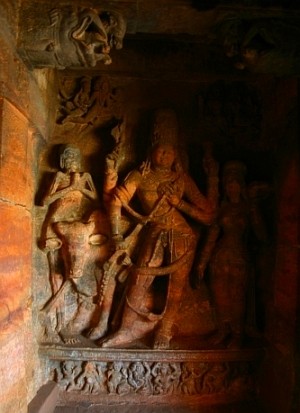
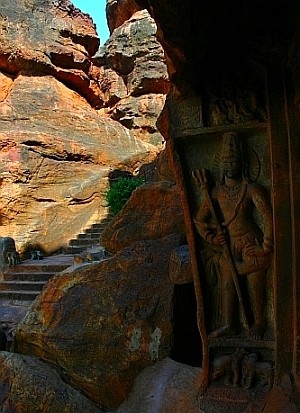
Carvings inside the cave temples at Badami.
The cave temples have beautiful carvings in them. Some of them are amusing, looking like Hanuman from one direction, and like a woman carrying a pot from another direction. Each cave temple is in a different level, and we have to climb up to go from one to other, through stairs carved on the hill itself. Near the second cave temple, there is a pathway going up, to the top of the hill, where the remains of Pulikeshi's fort are located. The stairs in this pathway are very tall, each up to 2.5 feet high; However, visitors cant try climbing those stairs, as the pathway has been closed by the Government now.
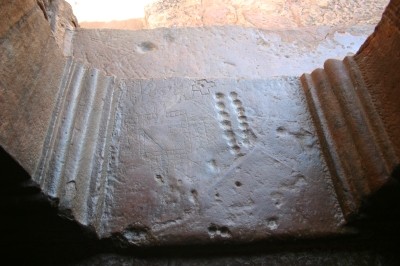
From the flooring of a Badami cave - These point us to a lighter moment in the life of the architects.
They might have spent several hours playing games here, 1400 years ago.
The view of the landscape from the fourth cave temple is breathtaking. We could see a vast pond (it is called Agasthya Theertha, and was dug in the fifth century) on the other side of the hill, filled with dark green water. At one corner of the pond, there are two temples seen - One built in North Indian architecture style, and the other one in Dravidian style. On the other side of the pond, there are more rocky hills. It seems there is one more cave temple on one of these hills. An 18th century Muslim tomb is also seen near the banks of this pond (The guide explained in Kannada regarding whose tomb it was; but I couldnt understand that). The green of the pond, blue of the sky and red of the stones made an amazing blend of colors and the pleasant breeze made us feel that we should spend a whole day there. But we didn’t have even enough time to go near the pond. We climbed down, and then it was time to travel to the next destination.
We had lunch from a KSTDC Mayura restaurant at Badami. This was as bad as the one at Hampi, and I had a very bad meal from there. After the lunch, we got back to the bus and then we started towards Pattadakal.
Pattadakal
On the way to Pattadakal, we saw a board showing the way to Mahakoota. There is an ancient temple there, built in the Chalukya period, and it seems this temple is in the middle of a dense forest, and we can enter it only by crossing a small pool by foot. It sounded very romantic.
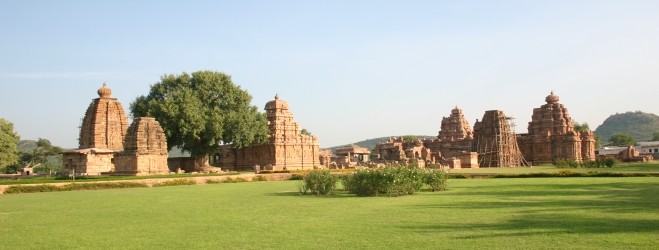
Temples at Pattadakal
We reached Pattadakal at 4PM. Pattadakal is the place where the Chalukyan kings used to be crowned, and they have built several temples in this area dating to 7th to 9th century. It seems Chalukyas were experimentalists in Architecture, and Pattadakal shows the peak of experimentation among their three sites, the first two being Aihole and Badami. They experimented with the shapes of roofs and gopurams, alignments of tiles, types of stones used, etc. The subjects for carvings are also selected imaginatively. There are not only images of gods and dancers, but there are stories from Puranas, Ramayana, Mahabharata and Panchathanthra which the architects have carved inside these temples. Some of the granite Shivalingas in the temple are so smoothly polished that they look as if they are made of metal. It seems the oldest monument at Pattadakal is a 3rd century mandapa that was uncovered by the Archaeological Survey of India in 1970.
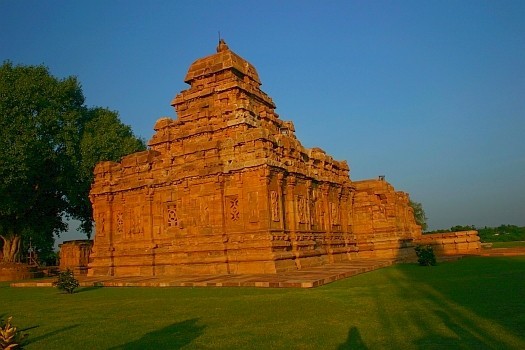
A temple at Pattadakal
The archeological department has maintained this temple complex well and there is a beautiful lawn around the temples, reminding the temples at Halebid and Somanathapuram. The only temple which is still being worshipped inside the temple complex is Virupaksha temple, built by the queen of Vikramaditya II in the 8th century, commemorating the king's victory over the Pallavas. There are carvings inside this temple, in a script looking like Kannada, and it seems the names of the sculptors are mentioned in these inscriptions. A beautifully carved, huge idol of Nandikesha is installed inside a mandapam facing the Virupaksha temple. Interestingly, the pujari in the temple was a young boy wearing a lunki.
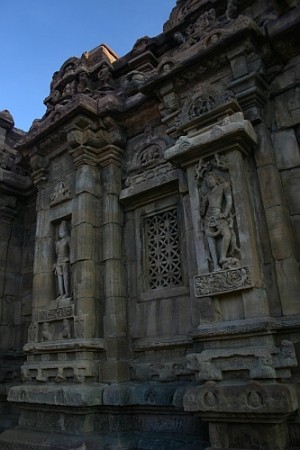
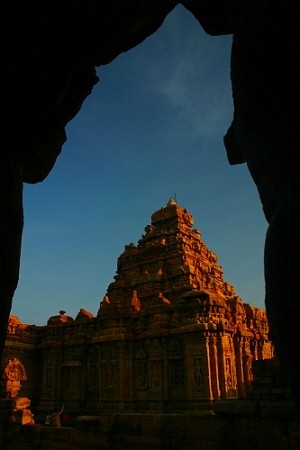
Views from Pattadakal temples
A river called Malaprabha flows behind the Pattadakal temple complex. We spent few minutes in front of the river, and then came back. It was 5:15 and the temples shined in the beautiful evening sunlight, making a wonderful sight. Our guide asked us to hurry up, as Aihole would close at 6, and we have to reach there before that.
Near the gate of Pattadakal temple complex, there was a large heap of fresh corn that nearby farmers had deposited. When we got into the bus, we saw that many of our co-passengers had one or two corns in their hand, flicked from the farmer's heap.
Aihole
Aihole (Aryapura) was the capital of Chalukyas until the sixth century, after which they shifted to Badami. It has a unique place in the history of Indian temple architecture, and it seems Aihole was the Chalukyan site for early experimentation in architecture. There are more than a hundred temples built at Aihole by the early Chalukyan kings from the fifth to eighth centuries. Most of them were Vaishnavite temples, and they were later converted to Saivite ones. Recent excavations have lead to the discovery of a pre-Chalukyan stone temple at Aihole, it seems - All these I learned from the board installed by the archeological department. It seems some of the temples were used as residence by the local chieftains after the Chalukyan period.
When we neared Aihole, we started seeing ancient temples almost everywhere, like small houses. There were few huts also in between, in front of which few village children were sitting and waving hands at the bus. We were to visit only few important temples inside an enclosed complex, protected by the archeological department. We reached there at 5.50, just in time. We ran to the ticket counter, bought the tickets and got inside. It was rapidly becoming dark, and we had only few minutes to have a quick view of the temples. At 6:30, the security guards started whistling, asking all visitors to go out. We sadly went back to our bus, and then we started our journey to Bijapur.
It was a tiring day and I slept nicely in the bus. I got only at 9PM, when the bus stopped in front of Samrat hotel at Bijapur. We were now 613 kilometers north of Bangalore, and almost near the Maharashtra border. We were allotted rooms in the hotel, and were asked to get ready at 8AM on the next day. There was a Kamat restaurant nearby, and we had a nice jawar roti meal from there, the first good meal that we had since we started from home. We slept peacefully.
We got up early on Saturday (November 5), at 5AM, as we were asked to be ready by 6. Hot water was available in the hotel, so we quickly took bath and checked out from our room. However, it was nearly 7 by the time all the passengers got ready and the bus started. Then, we were stuck in a traffic jam for an hour on the way. The bus stopped at a place called Kushtagi for breakfast, at 9. There was a pathetic restaurant in front of the KSRTC bus stand, and we took idli vada from there. The journey continued. Our next destination was the Banashankari temple.
The way to Banashankari was beautiful. The road was not so good, but on both sides of the road we could see unending farmlands, mostly sunflower. We rarely saw a house or any human being on the way. When we reached a place called Gajendragarh, a magnificent hill stretching to several kilometers became visible. Its top looked as if some architect had cut it off using a scale. Remains of a fort were seen on its top, at some places, but I couldn’t figure out which fort it was. After sometime, we could see a smaller hill, in front of the longer one, and there were caves visible near its peak, which looked like ancient ones.

We reached Banashankari at 11:30. Our guide asked us to visit the temple and come back within 20 minutes!
The Banashankari temple was built by the Chalukyas surrounding an ancient shrine, but presently only few parts of the ancient temple remain, and rest all were renovated during the 17th century. Adjacent to the main temple, we could see an underground temple dedicated to Shiva. But it looked like in ruins, and we didn’t enter it. In front of the temple, there is a vast pond called Harischandra Theertha which is considered to be very sacred. There are corridors with stone pillars and roofs around the pond. Unfortunately, there was not a drop of water in the pond, or else it would have made an even more splendid sight. I was surprised at this, as I had been hearing about heavy rains at almost every place in South India, and still it seemed like there was no rain at Banashankari.

The heat was intense, and we had tender coconuts from a vendor nearby. Then, the bus started towards Badami.
Badami
Badami (Vatapi) was the capital of the Chalukyas during 6th to 8th centuries. Pulikeshi II was the most famous ruler among Chalukyas, and during his time the Chalukyan empire covered almost the entire South India. Under their patronage, Badami, Pattadakal, Aihole and Mahakoota flourished as centers of Hindu religion and art. After the decline of Chalukyan empire, Badami was occupied by Rashtrakutas, Vijayanagara rulers, and finally by Tipu Sultan - These are all the info that I got from an informatory board installed by the archeology department.
We were given an hour at Badami, and a new local tourist guide came with us to explain things. After taking the tickets, we started climbing the rocky hill where the famous cave temples are located. There are four temples in the hill; Two are dedicated to Vishnu, one to Shiva, and the topmost one is a Jain temple (which gives indications to the secular rule of the Chalukyan kings). The rocks on the hill, mostly red sandstone, look as if they are painted in red, and it makes a good sight. Several families of monkeys have made the hill their residence, and they move around freely everywhere.


The cave temples have beautiful carvings in them. Some of them are amusing, looking like Hanuman from one direction, and like a woman carrying a pot from another direction. Each cave temple is in a different level, and we have to climb up to go from one to other, through stairs carved on the hill itself. Near the second cave temple, there is a pathway going up, to the top of the hill, where the remains of Pulikeshi's fort are located. The stairs in this pathway are very tall, each up to 2.5 feet high; However, visitors cant try climbing those stairs, as the pathway has been closed by the Government now.

They might have spent several hours playing games here, 1400 years ago.
The view of the landscape from the fourth cave temple is breathtaking. We could see a vast pond (it is called Agasthya Theertha, and was dug in the fifth century) on the other side of the hill, filled with dark green water. At one corner of the pond, there are two temples seen - One built in North Indian architecture style, and the other one in Dravidian style. On the other side of the pond, there are more rocky hills. It seems there is one more cave temple on one of these hills. An 18th century Muslim tomb is also seen near the banks of this pond (The guide explained in Kannada regarding whose tomb it was; but I couldnt understand that). The green of the pond, blue of the sky and red of the stones made an amazing blend of colors and the pleasant breeze made us feel that we should spend a whole day there. But we didn’t have even enough time to go near the pond. We climbed down, and then it was time to travel to the next destination.
We had lunch from a KSTDC Mayura restaurant at Badami. This was as bad as the one at Hampi, and I had a very bad meal from there. After the lunch, we got back to the bus and then we started towards Pattadakal.
Pattadakal
On the way to Pattadakal, we saw a board showing the way to Mahakoota. There is an ancient temple there, built in the Chalukya period, and it seems this temple is in the middle of a dense forest, and we can enter it only by crossing a small pool by foot. It sounded very romantic.

We reached Pattadakal at 4PM. Pattadakal is the place where the Chalukyan kings used to be crowned, and they have built several temples in this area dating to 7th to 9th century. It seems Chalukyas were experimentalists in Architecture, and Pattadakal shows the peak of experimentation among their three sites, the first two being Aihole and Badami. They experimented with the shapes of roofs and gopurams, alignments of tiles, types of stones used, etc. The subjects for carvings are also selected imaginatively. There are not only images of gods and dancers, but there are stories from Puranas, Ramayana, Mahabharata and Panchathanthra which the architects have carved inside these temples. Some of the granite Shivalingas in the temple are so smoothly polished that they look as if they are made of metal. It seems the oldest monument at Pattadakal is a 3rd century mandapa that was uncovered by the Archaeological Survey of India in 1970.

The archeological department has maintained this temple complex well and there is a beautiful lawn around the temples, reminding the temples at Halebid and Somanathapuram. The only temple which is still being worshipped inside the temple complex is Virupaksha temple, built by the queen of Vikramaditya II in the 8th century, commemorating the king's victory over the Pallavas. There are carvings inside this temple, in a script looking like Kannada, and it seems the names of the sculptors are mentioned in these inscriptions. A beautifully carved, huge idol of Nandikesha is installed inside a mandapam facing the Virupaksha temple. Interestingly, the pujari in the temple was a young boy wearing a lunki.


A river called Malaprabha flows behind the Pattadakal temple complex. We spent few minutes in front of the river, and then came back. It was 5:15 and the temples shined in the beautiful evening sunlight, making a wonderful sight. Our guide asked us to hurry up, as Aihole would close at 6, and we have to reach there before that.
Near the gate of Pattadakal temple complex, there was a large heap of fresh corn that nearby farmers had deposited. When we got into the bus, we saw that many of our co-passengers had one or two corns in their hand, flicked from the farmer's heap.
Aihole
Aihole (Aryapura) was the capital of Chalukyas until the sixth century, after which they shifted to Badami. It has a unique place in the history of Indian temple architecture, and it seems Aihole was the Chalukyan site for early experimentation in architecture. There are more than a hundred temples built at Aihole by the early Chalukyan kings from the fifth to eighth centuries. Most of them were Vaishnavite temples, and they were later converted to Saivite ones. Recent excavations have lead to the discovery of a pre-Chalukyan stone temple at Aihole, it seems - All these I learned from the board installed by the archeological department. It seems some of the temples were used as residence by the local chieftains after the Chalukyan period.
When we neared Aihole, we started seeing ancient temples almost everywhere, like small houses. There were few huts also in between, in front of which few village children were sitting and waving hands at the bus. We were to visit only few important temples inside an enclosed complex, protected by the archeological department. We reached there at 5.50, just in time. We ran to the ticket counter, bought the tickets and got inside. It was rapidly becoming dark, and we had only few minutes to have a quick view of the temples. At 6:30, the security guards started whistling, asking all visitors to go out. We sadly went back to our bus, and then we started our journey to Bijapur.
It was a tiring day and I slept nicely in the bus. I got only at 9PM, when the bus stopped in front of Samrat hotel at Bijapur. We were now 613 kilometers north of Bangalore, and almost near the Maharashtra border. We were allotted rooms in the hotel, and were asked to get ready at 8AM on the next day. There was a Kamat restaurant nearby, and we had a nice jawar roti meal from there, the first good meal that we had since we started from home. We slept peacefully.
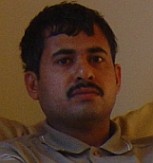

1 Comments:
Excellent post....
Planning to visit north karnataka after reading your article
Post a Comment
<< Home